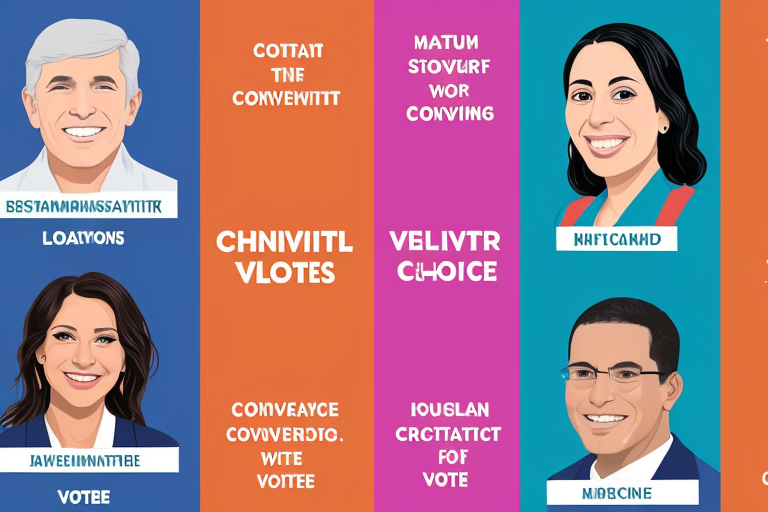The Power of Ranked Choice Voting
Ranked choice voting, also known as instant-runoff voting, is a voting system that allows voters to rank candidates in order of preference. This system is becoming increasingly popular in the United States as a way to address some of the issues with traditional voting systems.
The concept of ranked choice voting has been around for over a century, with the first use of the system taking place in Australia in 1918. Since then, it has been adopted by a number of countries and jurisdictions around the world.
The purpose of this article is to explore the pros and cons of ranked choice voting and to analyze whether it is an effective alternative to traditional voting. We will also examine the experiences of jurisdictions that have adopted or are considering ranked choice voting, as well as the arguments for and against the system.
Now, let’s dive into how ranked choice voting works and how it differs from traditional voting systems.
How Ranked Choice Voting Works
Ranked choice voting (RCV) is a voting system that allows voters to rank candidates in order of preference. Instead of selecting a single candidate, voters rank candidates from their most preferred to least preferred. RCV is used in a growing number of jurisdictions in the United States, including San Francisco, Minneapolis, and Maine.
When the votes are counted, the first-choice votes are tallied. If a candidate receives a majority of the first-choice votes, they are declared the winner. However, if no candidate receives a majority of the first-choice votes, the candidate with the fewest votes is eliminated. In our example, let’s say Uvanni received the fewest first-choice votes and is eliminated.
Now, the second-choice votes of the voters who ranked Uvanni first are redistributed to the remaining candidates. If Frankie ranked Uvanni third and Uvanni is eliminated, Frankie’s vote would be transferred to their second choice, Jane. The votes are tallied again, and if a candidate receives a majority of the votes, they are declared the winner. If not, the process of eliminating the candidate with the fewest votes and redistributing their votes continues until a candidate receives a majority.
RCV has several benefits. First, it encourages diverse and representative candidates. Candidates who may not have been elected under a traditional voting system have a better chance of winning because voters can rank them as their second or third choice. Second, RCV reduces polarization because candidates must appeal to a broader range of voters to win. Third, voters have more choice and can express their preferences more accurately.
However, RCV also has potential drawbacks. One concern is that it can be complex and confusing for voters. Voters may not understand how to rank candidates or how their votes will be counted. Additionally, implementing RCV can be technically challenging and expensive for election officials. Finally, there is a potential for lower voter turnout because some voters may not participate in an election if they do not understand how RCV works.
Jurisdictions that have Adopted or Are Considering Ranked Choice Voting
Ranked choice voting has been gaining popularity in recent years, with several cities and states adopting the system. In this section, we will take a closer look at some of these jurisdictions and their experiences with ranked choice voting.
One of the earliest adopters of ranked choice voting was San Francisco, which implemented the system in 2004. Since then, several other cities in California have followed suit, including Oakland, Berkeley, and San Leandro. In these cities, ranked choice voting has been praised for encouraging more diverse and representative candidates to run for office. For example, in the 2018 Oakland mayoral race, ranked choice voting allowed a relatively unknown candidate, Cat Brooks, to finish second in the first round of voting and ultimately come within a few hundred votes of winning the election.
Another city that has adopted ranked choice voting is Minneapolis, which implemented the system in 2009. In the 2013 mayoral race, ranked choice voting allowed a candidate named Betsy Hodges to win despite not receiving the most first-choice votes. Instead, Hodges won because she was the second choice of many voters whose first-choice candidates were eliminated in earlier rounds of voting. However, ranked choice voting has not been without controversy in Minneapolis, with some critics arguing that the system is too confusing for voters and that it unfairly advantages certain candidates.
Outside of California and Minnesota, several other jurisdictions have also adopted or are considering ranked choice voting. These include Maine, which became the first state to use ranked choice voting in statewide elections in 2018, and New York City, which will use ranked choice voting for the first time in the 2021 municipal elections. In Maine, ranked choice voting has been credited with reducing negative campaigning and increasing voter turnout. However, the system has also faced legal challenges, with a judge ruling in 2017 that ranked choice voting was unconstitutional for state-level elections (the ruling was later overturned by the state’s supreme court).
As more jurisdictions consider adopting ranked choice voting, it is worth considering the experiences of those that have already done so. While the system has its pros and cons, it has shown promise in encouraging more diverse and representative candidates and reducing polarization. However, it also has technical challenges and can be confusing for voters who are not familiar with the system. Ultimately, whether or not ranked choice voting is an effective alternative to traditional voting will depend on a variety of factors, including the specific context in which it is used and the preferences of individual voters.
Encouraging Diverse and Representative Candidates
Ranked choice voting has the potential to encourage more diverse and representative candidates to run for office. In traditional voting systems, candidates often rely on their base of supporters to win elections. This can lead to a situation where candidates only appeal to a narrow group of voters, rather than the entire electorate.
With ranked choice voting, candidates are incentivized to reach out to a broader range of voters. Since voters can rank their choices, candidates must appeal to a wider range of voters to win. This can lead to more diverse and representative candidates, as they are forced to consider the needs and interests of a broader range of constituents.
One example of this is the recent mayoral race in Minneapolis, which used ranked choice voting. The race featured a diverse field of candidates, including several candidates of color and a transgender candidate. The winning candidate, Jacob Frey, was able to appeal to a broad range of voters, including those who ranked him as their second or third choice.
Another benefit of ranked choice voting is that it can reduce the influence of special interest groups. In traditional voting systems, special interest groups can have a disproportionate impact on the outcome of elections. This can lead to policies that benefit a narrow range of interests, rather than the broader public.
With ranked choice voting, candidates are incentivized to appeal to a broader range of voters, rather than just a narrow group of supporters. This can reduce the influence of special interest groups and lead to policies that benefit a broader range of constituents.
Frankie Uvanni, a political consultant who has worked on several ranked choice voting campaigns, believes that ranked choice voting can lead to more diverse and representative candidates. “When candidates know that they need to appeal to a broader range of voters, they are more likely to consider the needs and interests of a wider range of constituents,” he says.
Overall, ranked choice voting has the potential to encourage more diverse and representative candidates, while reducing the influence of special interest groups. While there are certainly challenges associated with implementing ranked choice voting, the benefits are clear. By promoting a more inclusive and representative democracy, ranked choice voting can help to build a stronger and more resilient society.
The Challenges of Ranked Choice Voting
While ranked choice voting has many potential benefits, it also poses several challenges. In this section, we will explore some of the cons of ranked choice voting and possible solutions to these issues.
One of the most significant challenges of ranked choice voting is the complexity and confusion it can cause for voters. Some voters may not understand how to rank their choices, leading to spoiled ballots or invalid votes. Additionally, the tabulation process can be confusing, and voters may not understand how their votes are counted.
To address these issues, jurisdictions that use ranked choice voting have implemented voter education programs. These programs aim to educate voters on how to rank their choices and how the tabulation process works. By providing clear and concise information, voters can make informed decisions and feel confident in their choices.
Another challenge of ranked choice voting is the technical difficulties of implementing the system. Some jurisdictions may not have the resources or infrastructure to support ranked choice voting, leading to errors or delays in the tabulation process. Additionally, some voting machines may not be compatible with ranked choice voting, leading to further complications.
To address these issues, jurisdictions can invest in upgrading their voting systems to support ranked choice voting. By ensuring that all voting machines are compatible with the system, jurisdictions can avoid technical difficulties and ensure a smooth tabulation process. Additionally, jurisdictions can hire technical experts to oversee the implementation of ranked choice voting, ensuring that the system is functioning correctly.
Finally, some critics of ranked choice voting argue that it may lead to lower voter turnout. This is because some voters may find the system too confusing or may not understand how to rank their choices. Additionally, some voters may feel that their vote does not matter if their preferred candidate is not in the top two.
To address these concerns, jurisdictions can implement voter education programs and outreach campaigns to encourage voter participation. By providing clear and concise information on how to rank choices and how the system works, voters can feel confident in their choices and understand the importance of their vote.
The Debate Over Ranked Choice Voting
Ranked choice voting has been a topic of debate among politicians, election officials, and voters alike. Supporters argue that it encourages more diverse and representative candidates, reduces polarization, and gives voters more choice. Opponents, on the other hand, argue that it is too complex and confusing for voters, poses technical challenges for implementation, and may lead to lower voter turnout. Let’s take a closer look at the arguments for and against ranked choice voting.
Arguments for Ranked Choice Voting
Encouraging Diverse and Representative Candidates
One of the main arguments for ranked choice voting is that it encourages more diverse and representative candidates to run for office. Under the traditional first-past-the-post system, candidates who do not belong to the two major parties may have a difficult time winning elections. This can lead to a lack of diversity in elected officials and a feeling of disenfranchisement among voters who do not feel represented by the candidates on the ballot.
Ranked choice voting, however, allows voters to rank their choices in order of preference, which can give third-party and independent candidates a better chance of winning. This can lead to a more diverse pool of candidates and a more representative government.
Reducing Polarization
Another argument for ranked choice voting is that it can help reduce polarization in politics. Under the current system, candidates often engage in negative campaigning and attack ads, which can lead to a divisive and polarized political climate. Ranked choice voting, however, encourages candidates to appeal to a broader range of voters and to focus on issues that are important to all voters, not just their base.
Voters Have More Choice
Finally, supporters of ranked choice voting argue that it gives voters more choice and more control over the electoral process. Under the traditional system, voters may feel like they have to choose between the lesser of two evils, or that their vote doesn’t really matter. Ranked choice voting, however, allows voters to express their preferences more fully and to have a say in the outcome of the election.
Arguments Against Ranked Choice Voting
Complexity and Confusion for Voters
One of the main arguments against ranked choice voting is that it is too complex and confusing for voters. Under the current system, voters simply choose one candidate to support. With ranked choice voting, however, voters must rank their choices in order of preference, which can be difficult for some voters to understand.
Technical Challenges of Implementation
Another argument against ranked choice voting is that it poses technical challenges for implementation. Under the current system, votes are counted by a simple majority, which is relatively easy to tabulate. With ranked choice voting, however, votes must be counted in multiple rounds, which can be more time-consuming and expensive.
Potential for Lower Voter Turnout
Finally, opponents of ranked choice voting argue that it may lead to lower voter turnout. Under the current system, voters know that their vote will count for one candidate. With ranked choice voting, however, voters may feel like their vote doesn’t matter as much, or that the process is too confusing to bother with.
Analysis of the Arguments
While both sides of the debate make valid points, it is clear that ranked choice voting has the potential to address many of the shortcomings of the current system. By encouraging more diverse and representative candidates, reducing polarization, and giving voters more choice, ranked choice voting can help create a more fair and democratic electoral process.
However, the technical challenges of implementation and the potential for lower voter turnout cannot be ignored. It is important to ensure that the system is easy to understand and that voters have the resources they need to participate fully in the process.
Ultimately, the decision of whether to adopt ranked choice voting should be based on a careful analysis of the pros and cons, as well as the specific needs and circumstances of each jurisdiction. While it may not be the perfect solution for every situation, ranked choice voting has the potential to be a valuable alternative to the traditional system.
The Arguments for and Against Ranked Choice Voting
Ranked choice voting has been a topic of debate in recent years, with proponents arguing that it encourages diverse and representative candidates, reduces polarization, and gives voters more choice. However, opponents argue that it is too complex and confusing for voters, presents technical challenges for implementation, and may lead to lower voter turnout. In this section, we will examine these arguments in more detail.
Arguments for Ranked Choice Voting
Encouraging Diverse and Representative Candidates
One of the main arguments in favor of ranked choice voting is that it encourages diverse and representative candidates. Under traditional voting systems, candidates who are not part of the two major parties often struggle to gain traction, as voters may feel that voting for a third-party candidate is a wasted vote. Ranked choice voting eliminates this problem by allowing voters to rank their choices, which can lead to more diverse and representative candidates being elected.
Reducing Polarization
Another argument in favor of ranked choice voting is that it can reduce polarization. Under traditional voting systems, candidates may focus on appealing to their base rather than reaching out to voters outside of their party. This can lead to increased polarization and gridlock. Ranked choice voting encourages candidates to appeal to a broader range of voters, as they need to be able to appeal to voters who may not have ranked them as their first choice.
Voters Have More Choice
Finally, supporters of ranked choice voting argue that it gives voters more choice. Under traditional voting systems, voters may feel that they have to choose between the lesser of two evils. Ranked choice voting allows voters to rank their choices, which can lead to more nuanced and thoughtful decision-making.
Arguments Against Ranked Choice Voting
Complexity and Confusion for Voters
One of the main arguments against ranked choice voting is that it is too complex and confusing for voters. Under traditional voting systems, voters simply vote for their preferred candidate. Ranked choice voting requires voters to rank their choices, which can be confusing for some voters. This can lead to errors and spoiled ballots.
Technical Challenges of Implementing Ranked Choice Voting
Another argument against ranked choice voting is that it presents technical challenges for implementation. Under traditional voting systems, votes are simply counted and the candidate with the most votes wins. Ranked choice voting requires a more complex tabulation process, which can be difficult to implement and may lead to errors.
Potential for Lower Voter Turnout
Finally, opponents of ranked choice voting argue that it may lead to lower voter turnout. Under traditional voting systems, voters may be more likely to turn out to vote, as they feel that their vote will have a greater impact. Ranked choice voting may lead to confusion and apathy among voters, which could lead to lower voter turnout.
Analysis of the Arguments
Overall, the arguments for and against ranked choice voting are complex and nuanced. While supporters argue that it encourages diverse and representative candidates, reduces polarization, and gives voters more choice, opponents argue that it is too complex and confusing for voters, presents technical challenges for implementation, and may lead to lower voter turnout.
Ultimately, whether or not ranked choice voting is an effective alternative to traditional voting systems depends on a variety of factors, including the specific context in which it is implemented. However, it is clear that ranked choice voting has the potential to address some of the shortcomings of traditional voting systems and should be considered as a potential alternative.









